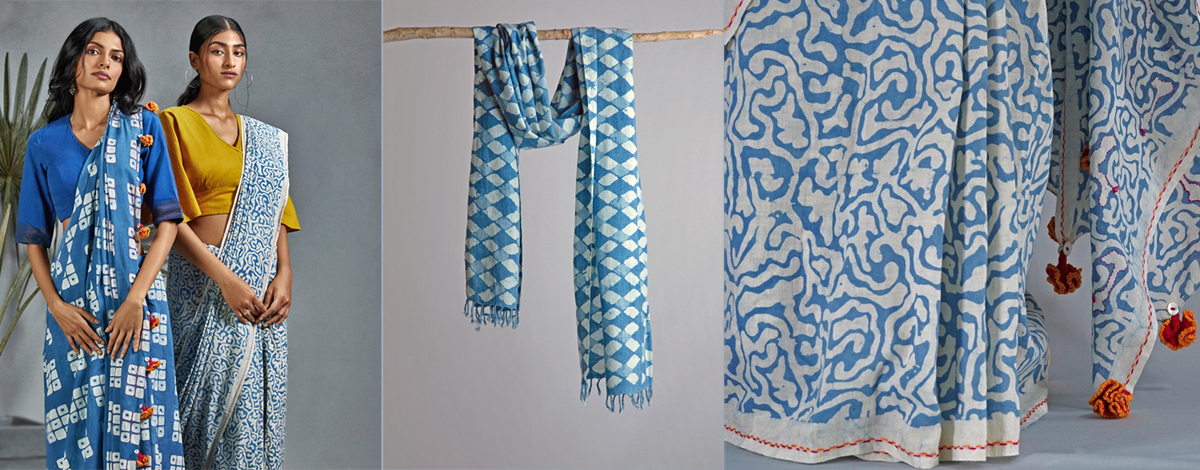Free shipping in India/Flat $16 Worldwide.


The word batik is Javanese in origin. It comes from the Javanese ‘ambatik’ that consist of amba means “wide” or “large”, and tik or nitik means “make a dot”. (Wikipedia) It has been practiced for centuries in many parts of the world including but not limited to Indonesia, China, Japan, India, South America, Africa and some parts of Europe.
Batik is a technique of wax-resist dyeing applied to a textile. The applied wax resists dyes and therefore allows the artisan to color selectively by soaking the cloth in one color, removing the wax with boiling water, and repeating if multiple colors are desired.
In this article we will take a look at the process of Batik as practiced by the Khatri community near Mundra, Gujrat. We have been working with Shakil ji based in this region whose family has been practicing this craft of Batik printing for six generations. Several of his family members and employed artisans help run the workshop. We had our handwoven muslin sarees, tassar silk scarves and Eri peace silk stoles printed using this surface treatment. Thanks to Shakil ji, the more we learn, the more we appreciate the process and the artisans who have been carrying on this heritage, despite the onslaught of machine made fabrics. We are excited about the design possibilities this heritage technique allows.
While we design most prints in-house, this is a collaborative process, based on artisan’s feedback on the initial design idea. This medium is best suited for bolder design patterns as molten wax tends to be runny, complex, dense motifs may not always work well. Based on Shakil Ji’s feedback I had to modify my drawing to make the seamless pattern more spaced out so that it printed well with runny molten wax. Also notice the carved wood block specially designed for Batik, you will notice small holes that you don’t see in the drawing. The purpose of drilling these holes is to curb the runniness of the molten wax as it settles in these holes lending a crisp print.
There are also metal blocks that are used in Batik printing, one made of metal, called stamp, another kind with metal nails installed on a wooden base.
The printing table setup is unique to Batik Printing, a stove keeps the wax molten, the table is covered with wet sand so that wax permeates the fabric entirely, resulting in an almost reversible print. The wet sand lets the wax cool off on contact with the fabric quickly. Accuracy while printing with wax is very important.
We wrap up with a review of the batik process
*Fabric is washed and dried to make it ready for dyeing.
*This cloth is then printed with specialized blocks using molten wax.
*The fabric is then vat dyed either using chemical colors or natural dyes( all our Batik prints are dyed in natural dyes)
*Dyed fabric is washed in boiling water to remove wax.
*Wax is then collected to be reused in printing.
*This process maybe repeated if multiple colors are to be achieved.
All Copyright © 2021 fyolifyoli
Designed, Developed, Marketed & Managed by Tenjump
All Copyright © 2021 fyolifyoli
Designed, Developed, Marketed & Managed by Tenjump
| Cookie | Duration | Description |
|---|---|---|
| cookielawinfo-checbox-analytics | 11 months | This cookie is set by GDPR Cookie Consent plugin. The cookie is used to store the user consent for the cookies in the category "Analytics". |
| cookielawinfo-checbox-functional | 11 months | The cookie is set by GDPR cookie consent to record the user consent for the cookies in the category "Functional". |
| cookielawinfo-checbox-others | 11 months | This cookie is set by GDPR Cookie Consent plugin. The cookie is used to store the user consent for the cookies in the category "Other. |
| cookielawinfo-checkbox-necessary | 11 months | This cookie is set by GDPR Cookie Consent plugin. The cookies is used to store the user consent for the cookies in the category "Necessary". |
| cookielawinfo-checkbox-performance | 11 months | This cookie is set by GDPR Cookie Consent plugin. The cookie is used to store the user consent for the cookies in the category "Performance". |
| viewed_cookie_policy | 11 months | The cookie is set by the GDPR Cookie Consent plugin and is used to store whether or not user has consented to the use of cookies. It does not store any personal data. |
Register


Login to your account